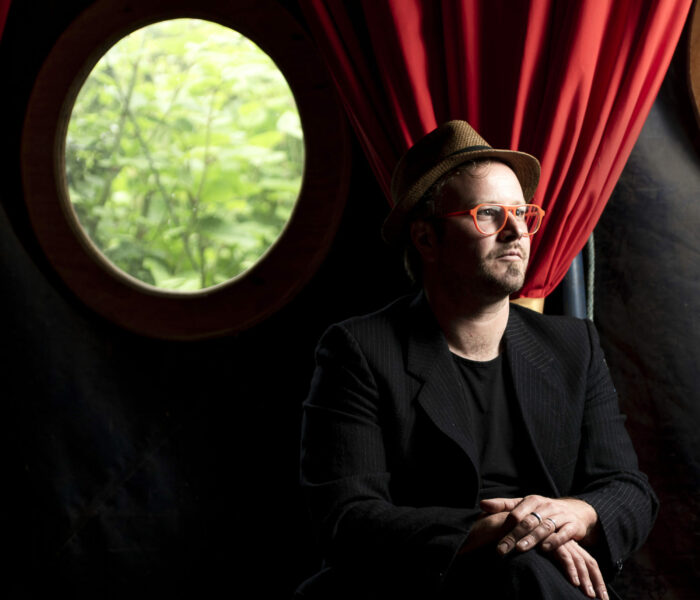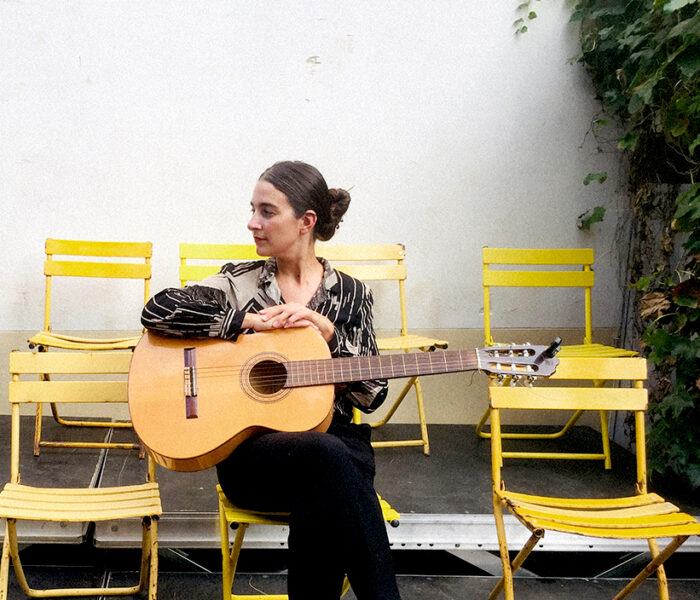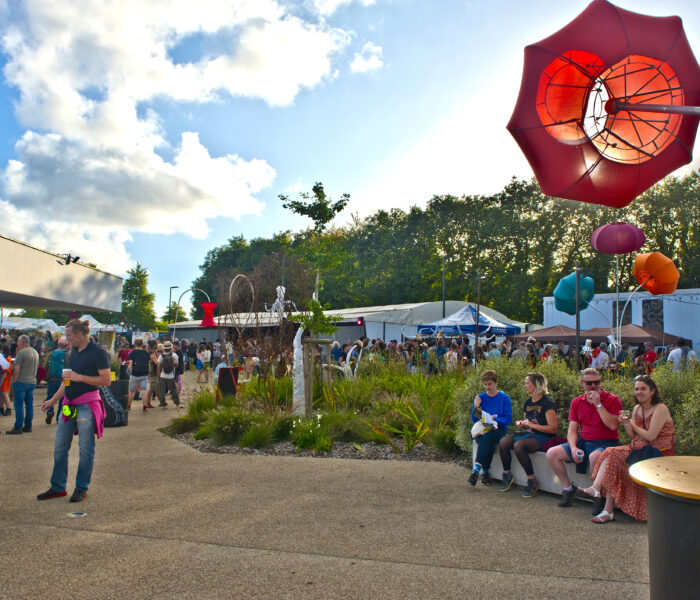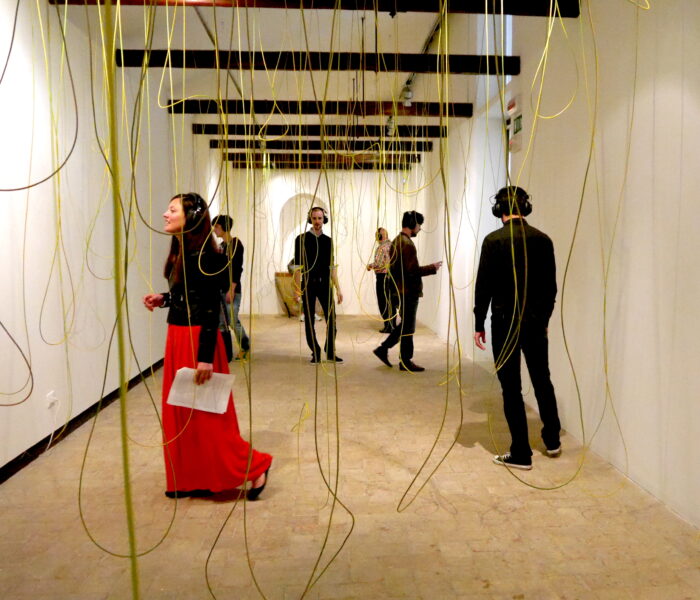À l’occasion du Festival du Nouveau Printemps, Julien Desailly musicien multi-instrumentiste (cornemuses, mais aussi flûtes, percussions, etc.) a conçu avec l’artiste plasticienne Camille Grosperrin une installation à la fois sculpturale et sonore au cœur de la Chapelle de la Grave (du 2 juin au 3 septembre 2023). Explorateur du répertoire traditionnel, membre de Pancrace, Dix-Sept Saturnes, Gésir, le Duo Decaze/Desailly, Mafila Ko et l’Hexagonal Pipers Club, Julien Desailly développe aussi toute une série de projets aux plus près des territoires à la rencontre et/ou en lien avec les habitants tels que des tournées en vélo avec A Spurious Tale ou encore le film La fête de Boissières n’aura pas lieu.
Julien Desailly , quelle est la place de l’instrumentiste dans l’art ?
Je n’ai jamais abordé cette question frontalement. Il est vrai que je me définis comme un instrumentiste, concentré en particulier sur un instrument qui me suit partout : la cornemuse. Ce n’est pas anodin comme façon de se présenter, cela donne un contour à ma pratique de la musique, et elle passe principalement par cet objet fait d’une poche, d’anches, de tuyaux, qui revêt une charge particulière jusqu’à devenir un objet de pouvoir, dans un sens animiste.
Les relations des instrumentistes à leurs instruments m’intéressent et on oublie parfois à quel point c’est une part importante de la musique produite. Il existe ce travers qu’en étant concentré sur ce que l’on veut jouer, on en oublie en route la nature de la relation que l’on entretient avec notre instrument.
En fait — et peut-être que cela répondra un peu à ta question — je crois que trop souvent, l’on confond l’instrumentiste avec l’interprète, C’est-à-dire une sorte d’exécutant ayant plus ou moins de liberté par rapport à sa partition (qu’elle soit écrite ou pas).
Ce qui me plaît et qui définit mieux l’instrumentiste à mon sens, c’est ce duo humain-objet, et que tout ce que l’on raconte passe par cet objet, comme unique canal. D’où mon intérêt pour la facture instrumentale, la fabrique du son commence par la fabrication de l’instrument. Et l’objet n’est pas nécessairement fixé, il peut toujours être modifié, évoluer, comme nous.
Dans votre parcours, à quel moment cette place est-elle devenue un questionnement ?
Je balade ma cornemuse dans des contextes très différents, mais je viens des musiques traditionnelles, et j’ai appréhendé mon instrument dans ce milieu.
Cela a son importance car la place qu’on envisage d’occuper en tant qu’instrumentiste et musicien est très différente au sein de ces musiques. Qu’il s’agisse d’accompagner des événements importants de la vie (enterrements, mariages, fêtes…), de faire danser (bal), de jouer dans des lieux où se joue une vie sociale (bar, pub en Irlande), à chaque fois tu partages des codes avec une communauté qui les comprend. À défaut d’une place dans l’art tu endosses d’emblée un rôle social.
Même si j’ai tendance à expérimenter et à m’éloigner de ces musiques à ancrages territoriaux, elles forment un socle. Cela se traduit par des enjeux rythmiques qui, au fond, viennent de la danse. Et ça m’a aussi orienté vers une certaine façon de concevoir la variation — le même mais différent à chaque fois, c’est la ritournelle de “Mille Plateaux” de Deleuze— très présente dans les musiques traditionnelles que j’affectionne.
Dans des groupes comme Pancrace, Duo DesaillyMaurel, ou Gésir, je m’appuie sur ces préoccupations, en les étirant, alors que ces formes n’ont en apparence pas de rapports avec les musiques traditionnelles. D’ailleurs, la plupart du temps mes comparses n’ont aucun lien avec ces musiques.
Au contraire, dans A Spurious Tale, Dix-Sept Saturnes, Mafila Ko, Hexagonal Pipers Club, je joue avec des personnes qui évoluent dans le milieu des musiques traditionnelles, et quels que soient leurs origines géographiques et différences culturelles, nous avons chacun un pied sur le socle que j’évoquais.
Plus tard, lorsque j’ai été davantage confronté au format du concert, cette question de la posture a pris une nouvelle tournure. Le concert est un dispositif qui m’a souvent dérangé, peut-être justement parce qu’il y a des distorsions avec ce que sont les musiques traditionnelles originellement. En effet, c’est un tout autre rapport, on y vient pour écouter de la musique (ce qui finalement est assez bizarre), il y a un espace pour le public et un autre pour les artistes (et le fossé est grand !), les artistes sont placés sur un piédestal, les musicien·n·es, chanteurs·euse·s sont des artistes (ce qui n’a rien d’évident socialement), les enjeux sociaux sont moindre et d’ailleurs le concert ne s’adresse qu’à une caste réduite, on fait le noir dans une salle dédiée, c’est un spectacle. Les musiques traditionnelles ne sont pas des spectacles, ou pas uniquement, et je pense qu’une part de mes questionnements viennent de là.
Et en même temps le format concert permet de faire entendre des choses très fines, précises, de développer des idées qui n’auraient pas leur place ailleurs, et une certaine concentration y est possible.
Comment ce questionnement a suscité chez vous de nouvelles formes ? Quelles formes ?
En fait, je crois qu’on a du mal à se débarrasser des héritages d’une musique d’élite, et je crois qu’on essaye tous, de manière très diverse, de rétablir du sens dans cette pratique du concert. Que cela soit du côté des artistes, des festivals, des politiques culturelles, des salles… Il y aurait beaucoup à dire sur les salles de concert, c’est un problème architectural aussi.
Il me semble qu’on arrive à un moment, en France où il y a une profusion de propositions musicales, mais finalement les lieux où elles peuvent s’épanouir sont parfois difficiles à trouver. Maintenant que la plupart des gens n’écoutent de la musique qu’à travers des enceintes, je trouve par exemple pertinent de créer des contextes d’écoute qui utilisent l’acoustique des instruments et des lieux.
Avec notre collectif Le Mange-Minutes, qui relie entre eux plusieurs groupes à la frontière des musiques traditionnelles, nous expérimentons différents formats en Auvergne (Haute-Loire). Par exemple, nous avons réalisé le film musical La fête de Boissières n’aura pas lieu, en collaboration avec les habitants du hameau de Boissières (en accès libre sur internet). Cette année nous organisons une tournée en tracteur, de village en village, du côté du Haut-Allier. Le tracteur tirera un plateau de paysan transformé en scène, le tout alimenté par des batteries de camion. Nous sommes quelques-uns au sein du collectif à être issu de milieux ruraux, et nous essayons de proposer des formes adaptées et exigeantes à ce public souvent oublié.
Dans ce sens, avec le groupe A Spurious Tale nous nous sommes lancés dans des tournées en vélo, de Strasbourg à Brest, avec plus de vingt concerts en un mois sur le chemin. Nous l’avons fait trois années consécutives. Nous passions d’un squat, à une médiathèque, à une salle tout équipée, à un salon de thé, ou encore à un concert en extérieur… Pour nous, ce sont des modalités de concerts qui ont plus de sens que de jouer chaque soir dans une grande salle noire, visant la neutralité (un standard qui n’est pas sans rapport avec le white cube de rigueur dans les milieux artistiques), puis de se réveiller le lendemain dans un hôtel avec toujours le même tableau au mur (coquelicot, New-York en noir et blanc ou pierres-zen).
Je ressens un vrai plaisir à chercher la posture qui me convienne le mieux, qui me paraît la plus juste, pour répondre à un contexte donné, m’adapter à d’autres artistes, à un autre public. C’est de l’ordre du jeu que de tenter de comprendre où nous sommes et à qui nous avons à faire.
En quoi ces nouvelles formes que vous expérimentez interrogent-elles la question de la place de l’écoute, de celle du public ?
Je suis sur plusieurs fronts. Il y a ce souci du contexte, des personnes, et c’est un vrai enjeu. Tout est à faire sur ce terrain, mais l’écoute ne peut se résumer à un public venant consommer ce que nous produisons. Cela commence par nous, musicien.ne.s, ingénieur.e.s du son… Nous avons tout intérêt à nous positionner sur cette question de l’écoute, qui est très concrète, mais aussi très intime.
Pour moi l’écoute est en rapport étroit avec l’espace. La cornemuse est un outil formidable pour faire sonner des lieux (en extérieur aussi), d’ailleurs le joueur de cornemuse est appelé “sonneur“. Je l’utilise beaucoup pour déclencher des espaces, explorer leurs propriétés acoustiques. Il y a quelque temps j’ai enregistré un disque en solo dans un château d’eau en Alsace (iii! chez le label Soleils Bleus), et la cornemuse agit comme un révélateur acoustique de cet endroit à la réverbération monstrueuse, qui va jusqu’à altérer certaines fréquences, effacer certains sons. Avec Zoé Heselton nous avions soigneusement choisi une place fixe et deux micros. À chacun des morceaux que j’enregistrais, j’associais un mouvement, parfois un véritable parcours. Par exemple en jouant une musique répétitive tout en montant et descendant progressivement dans le château d’eau.
Avec Léo Maurel, luthier-inventeur avec qui je collabore souvent, nous nous sommes attachés à développer différents phénomènes acoustiques dans notre musique. Cela nous a conduit à une plus grande attention à la physicalité du son, à la psychoacoustique et des recherches autour des timbres de nos instruments (vielles, cornemuses, orgue). On ne parle plus, alors, de notes, mais de fréquences, de battements, de sélection d’harmoniques, de microtonalité… Ce qui nous a conduit à l’orgue éclaté de Pancrace, groupe avec lequel nous sortons notre troisième disque cette année (Penultimate Press).
Il y a un piège dans lequel on tombe facilement en tant qu’instrumentiste : n’entendre que des notes ! Notre oreille étant déformée par l’apprentissage que l’on a subi, elle est habituée à ne tirer d’un son qu’une seule fréquence précise (ce qui est pratique pour faire des montages harmoniques complexes). Cela nous amène souvent à ne plus percevoir que cela, et à oublier ce qui constitue le son dans son entièreté. Et quand on a un instrument entre les mains, la fabrique du son commence par les matériaux qu’on utilise, leurs propriétés acoustiques… La cornemuse m’a assez rapidement plongé dans l’univers de la facture instrumentale. Régler mon instrument, faire mes anches, y ajouter un nouvel organe… la cornemuse n’est pas un instrument fini. Je travaille souvent avec des luthiers, notamment Léo, que j’ai aidé à réaliser une cornemuse motorisée (la TUI).
Plus récemment j’ai réalisé un instrument pour une pièce chorégraphique de Céline Cartillier Haut-Fond, jouée à Paris le 8 juin à l’occasion de june events. Dans cette pièce Céline tourne de la terre sur un tour de potier, et elle souhaitait que ce tour puisse aussi devenir instrument, produire sa musique. Avec la céramiste Camille Grosperrin, il m’a semblé logique de prolonger ces recherches à l’occasion de l’exposition au Dôme de la grave de Toulouse, dans le cadre du festival le Nouveau Printemps.
Ce n’est pas votre première collaboration avec Camille Grosperrin, comment cela vient-il nourrir votre travail ?
J’avais réalisé la musique de son film Diving Horses, qui se déroule dans l’État de New York et a pour sujet le dernier cheval plongeur, le vieux parc d’attraction qui l’abrite et les employés qui s’en occupent. J’aime bien faire de la musique pour le cinéma. Dans ce film, il y a une séquence musicale assez longue dans un tunnel, importante pour nous et qui témoigne du fait que la musique et les images se sont fabriquées au même moment. Alors que la norme est plutôt que l’un s’assujettit à l’autre ; on écrit souvent la musique une fois le montage du film avancé, ou l’inverse dans le cas du clip. Camille est, elle aussi, polyvalente : à la fois céramiste, dessinatrice et cinéaste. Notre collaboration prend des formes assez variées, même si jusqu’ici nous avons collaboré principalement sur des films. Avec Léo Maurel, encore lui, nous avons fait la musique de sa vidéo Pale Horse en 2013. Et plus récemment, nous avons participé, avec les ouvriers de l’usine des cannes Fayet, à une vidéo présentée à Thiers au Centre d’Art du Creux de l’Enfer. Il nous arrive aussi de dessiner ensemble, pratique que l’on a en commun. Mais à Toulouse, c’est la première fois que nous réalisons ensemble une pièce sculpturale. Avec le temps, notre collaboration s’affine et s’approfondit. C’est quelque chose que j’essaie d’entretenir avec d’autres personnes, comme Julien Moneret avec qui je joue dans plusieurs groupes, Céline Cartillier dans le domaine chorégraphique, Léo Maurel dont j’ai déjà parlé, Jean-Luc Guionnet avec qui j’improvise maintenant dans plusieurs projets, Fabienne Wagenaar dont je fais la musique d’un film d’animation, Adrian Smith, Jan Vysocki, Adama Koéta… et j’en oublie.
DIVING HORSES from Camille Grosperrin on Vimeo.
Comment avez-vous conçu cette installation ensemble ? Pouvez-vous la décrire ?
C’est la designer et artiste Matali Crasset qui nous a invité à exposer dans le dôme de la Grave. Je crois que quand elle a visité cet endroit, elle s’est dit que l’acoustique particulière du lieu pouvait m’intéresser, et c’est le cas ! Mais pour des raisons diverses, la part sonore s’est amenuisée au fur et à mesure du projet. D’abord pour des raisons techniques ; c’est un bâtiment historique et je ne pouvais rien placer en hauteur sur la corniche (pas d’enceintes par exemple). Effectivement, il aurait été intéressant d’utiliser à fond l’acoustique du lieu, mais cela aurait aussi nécessité d’atteindre un certain volume.
La pièce, “les invisibles”, doit être activée durant trois mois et des personnes travaillent là chaque jour et accueillent du public, nous avons donc essayé de nous soucier aussi de leur santé mentale ! Nous voulions aussi éviter que les sculptures de Camille ne soient réduites à un rôle illustratif, il fallait trouver la juste place du son dans ce projet. Nous avons donc décidé de faire sonner certaines des céramiques produites. Un moteur fait tourner régulièrement une céramique, ce qui a pour effet de mettre en mouvement une grande pousse d’aulne qui frotte et frappe la céramique par une de ces extrémités, et sur l’autre extrémité de l’aulne, Camille a conçu une sorte de gros grelot en céramique aux formes organiques. Chacune des extrémités de l’aulne produit des sons de nature très différente : frottement et percussion d’un côté et son presque cristallin de l’autre. En se déplaçant sous le dôme, l’équilibre entre ces deux sons change. Nous invitons les visiteurs à se déplacer et à écouter ce rapport qui se modifie en fonction de l’endroit où ils se situent. Le tout est porté par une charpente en bois brut, qui contraste avec l’aspect léché de la décoration du bâtiment. Camille a développé un univers autour de la faune et la flore de la Garonne. En effet, le dôme est construit au bord du fleuve sur une ancienne gravière. Elle a une grande affinité avec la figure animale et ses sculptures sont en partie réalistes, parsemées de détails fidèles, de silures, d’anguilles, de potamots dont elle extrait des motifs qu’elle répète. Les nageoires de silures deviennent des coquillages, les corps des anguilles deviennent cubiques. Une partie de ses modelages restent bruts, les collages sont apparents, et contrastent avec la finesse de certains éléments. Le dôme ayant connu une crue historique en 1875, ce n’est pas complètement incohérent d’y faire revenir les poissons, coquillages, algues. Cela donne à cette chapelle un petit côté crèche délirante et mouillée. Il y a une part d’humour, qui j’espère sera perceptible. Ces pièces céramiques sont parfois fixées à la charpente avec des chevilles en bois, elles viennent aussi se mêler aux assemblages des pièces de bois et nous avons pris beaucoup de plaisir dans l’association de ces deux matériaux, bois et céramique. La pièce sera visible tout l’été. Et nous avons programmé deux activations particulières de la pièce, sous une forme qui s’approche du concert, les 24 juin, avec Gésir (avec Camille Émaille et Jean-Luc Guionnet) et le 1er juillet, Les Autonautes de la Cosmoroute, avec Pol Small et Julien Moneret.
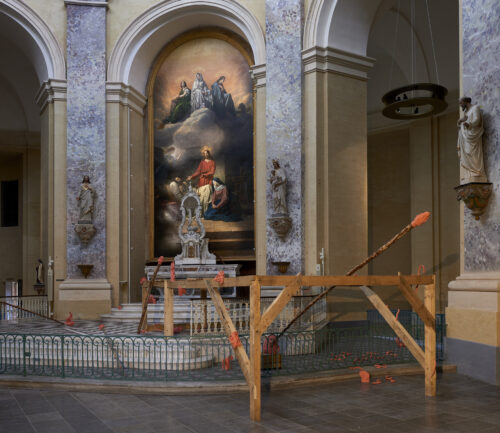
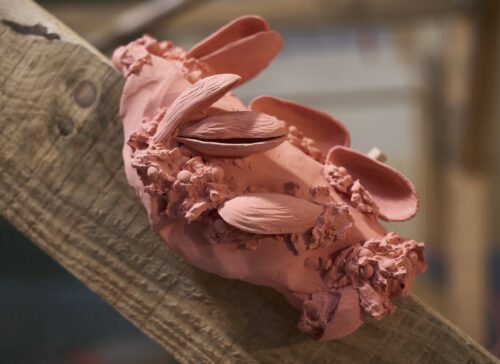
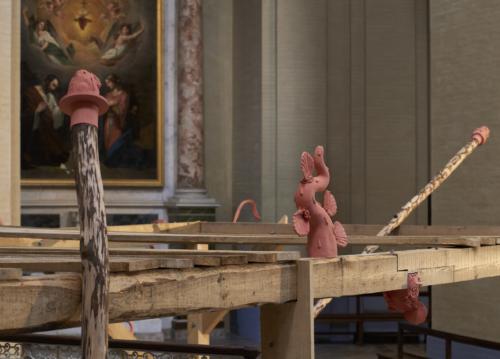
Propos recueillis par Anne-Laure Chamboissier
Photos © Damien Aspe



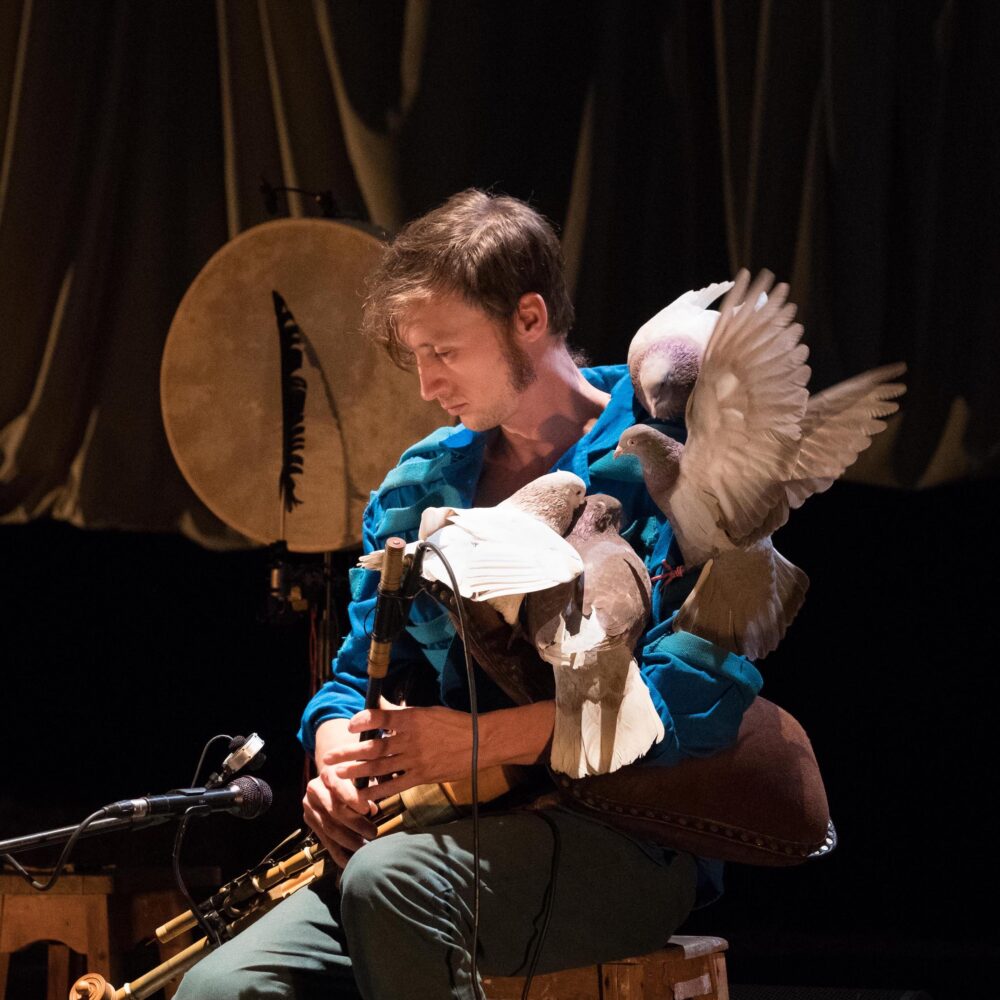)
